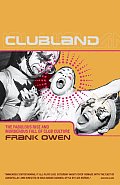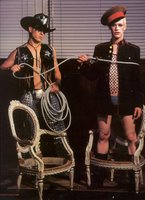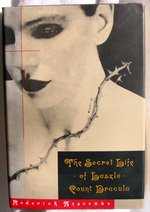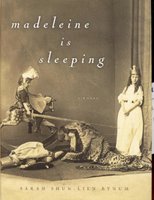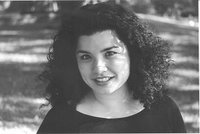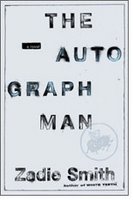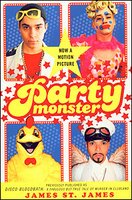
Party Monster
James St. James
DAMN ME! Why was I not born earlier??? WHY???? If I had been born just FIVE years earlier, I could have been a clubkid. Of course, I'd probably be dead by now if that were the case. But damn! What a way to go.
A quick overview for those poor souls unfamiliar with the clubkids: they were a group of club-goers (mostly male, mostly gay) who dressed outlandishly (it was fashion, dammit) (well, for most), took copious amounts of drugs, and were just all-around fabulous in the mid-nineties.
Many did not survive the club years: some overdosed, some disappeared entirely, and some were murdered. To be more specific, Angel Melendez was murdered (the guy with the wings on the cover of the book is Angel's film incarnation). Michael Alig (played by Macaulay Culkin in the top right of the book's cover) murdered Angel while in a drugged-out, murderous rage.
 The story is told by James St. James (pictured at left during his club days), Michael's Alig's sometime best friend. Rising from the depths of obscurity, Michael Alig became what's known as a party promoter: he threw fabulous parties at hip New York clubs, made sure all the fabulous people showed up, and kept them steeped in drugs all the while. For at time, Alig avoided the addictions that smothered so many of his acquaintances (few are true friends in this world), but when he fell, he fell hard.
The story is told by James St. James (pictured at left during his club days), Michael's Alig's sometime best friend. Rising from the depths of obscurity, Michael Alig became what's known as a party promoter: he threw fabulous parties at hip New York clubs, made sure all the fabulous people showed up, and kept them steeped in drugs all the while. For at time, Alig avoided the addictions that smothered so many of his acquaintances (few are true friends in this world), but when he fell, he fell hard.
Soon, his life was dictated by heroin, and he befriended Angel, the drug dealer with the wings whom they had all mocked heretofore. But Alig was a celebrity, making frequent appearances in the New York society pages, receiving free meals and limo rides, so why should he have to pay for his drugs?? Basically: lots of drugs + stealing from your dealer + lots and lots of drugs = a big, big problem.
Long story short: Alig went to jail (I believe he was released earlier this year) and James St. James went on to write this memoir. However, like any memoir (note to Frey haters), it is not complete fact. How on earth can anyone remember exactly what happened ten years ago, especially after being totally inundated with K for a period of several years?
Thus, if you're looking for cold, hard facts, read Clubland. Ignore my low rating. Had I based it on objectivity and top-quality research, it would have been rated higher. Party Monster, on the other hand, is anything but objective.
That said, the better story belongs to James St. James. I found myself laughing out loud and tearing through the pages as if I were a speed demon myself. In fact, Party Monster was so enjoyable I hope that St. James writes something other than this book; if he doesn’t, he will have turned Alig’s bitchy opinion (that James is nothing without him) into prophecy. He even had the nerve to say, “Isn’t that classic? How dare you, James, co-opt MY murder to make yourself look fabulous! Go commit your OWN murder and let me have my moment!” But St. James has real talent, and I hope he writes something non-Alig related that will gain him deserved praise.
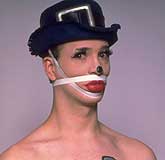 However, Party Monster is not without its flaws. It glamorizes Alig (at right), who was a junkie, racist, and straight-up lunatic before he even became a murderer. To this day, he blames his murder of Angel on the society that spawned him, without admitting to much real blame himself. Furthermore, this book makes being a loser addict look cool. To put it another way, I'm glad I didn't read this book 10 years ago, when it really would have messed me up.
However, Party Monster is not without its flaws. It glamorizes Alig (at right), who was a junkie, racist, and straight-up lunatic before he even became a murderer. To this day, he blames his murder of Angel on the society that spawned him, without admitting to much real blame himself. Furthermore, this book makes being a loser addict look cool. To put it another way, I'm glad I didn't read this book 10 years ago, when it really would have messed me up.
And yet, Michael remains so fabulous in my mind. DAMN YOU, MICHAEL! Why must you remain fabulous when you beat Angel with a hammer, stuffed him full of Drano, left him to rot for a week in your tub, and then cut off his legs and genitals before packing him in a box and shoving him in the river???? DAMN YOU! It’s like sympathizing with H.H., who only wants to love little Lolita.
Okay maybe not.
In a nutshell: Don't expect gospel from James St. James--but do expect a great tale told in a unique, hilarious voice. If you want facts, read Clubland. You'll have more fun with Party Monster, however.
Bibliolatry Scale: 5 out of 6 stars
 Magical Thinking
Magical Thinking Instead of tackling his dysfunctional family and insane childhood, Burroughs tackles the insanity of his adult life. And trust me, the adult Augusten is much, much more entertaining. You'll squirm as he kills a psycho rat in his NYC apartment, cackle as he torments a crazy cleaning lady, and feel all gooey inside as he finally meets a perfect match.
Instead of tackling his dysfunctional family and insane childhood, Burroughs tackles the insanity of his adult life. And trust me, the adult Augusten is much, much more entertaining. You'll squirm as he kills a psycho rat in his NYC apartment, cackle as he torments a crazy cleaning lady, and feel all gooey inside as he finally meets a perfect match.




